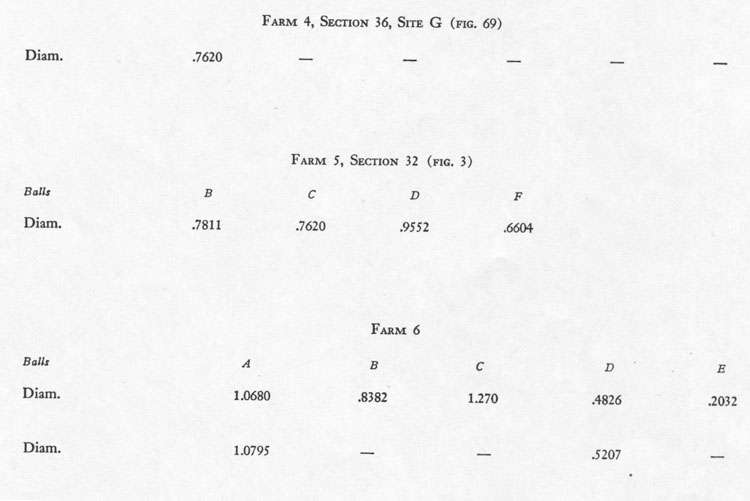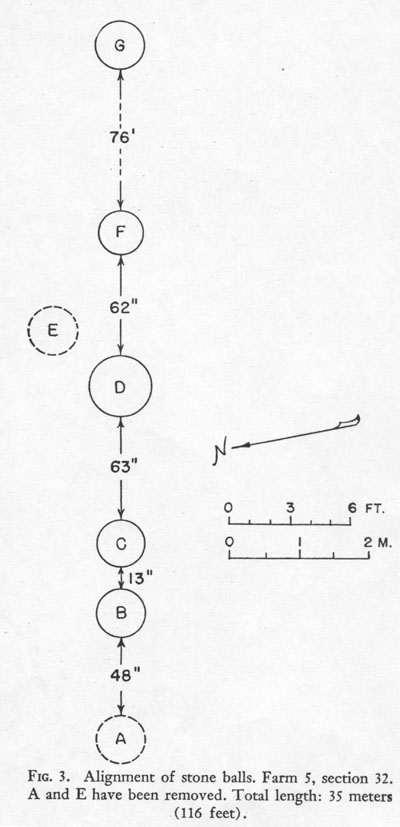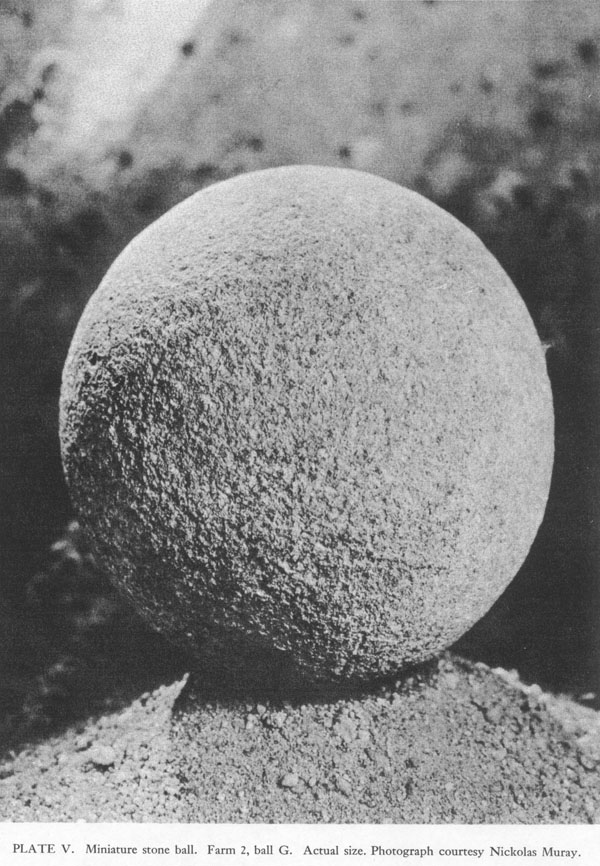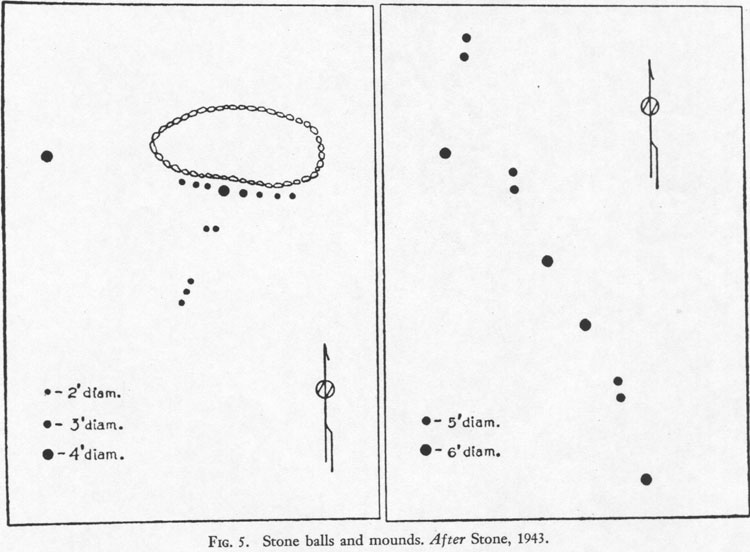FARMS 4 THROUGH 6

These are the final diameter readings recorded by Lothrop.
FARM 4, SECTION 36, G.
FARMS 4 THROUGH 6

These are the final diameter readings recorded by Lothrop.
FARM 4, SECTION 36, G.
Lothrop provides only one diameter for this farm section. He measured the stone ball to be 2.5-feet or 30-inches wide. Using PI @ 3.15 this converts to a coded circumference of 94.5-inches. A mathematical progression based upon 94.5 provides a string of both navigational and lunar numbers, essential to ancient calculations.
FARM 5, SECTION 32.

Another dynamic and carefully measured alignment on Farm 5, Section 32. In Lothrop's chart he gives the "in situ" measurements for stones B, C, D & F. Stones A & E had been removed to the farm manager's garden, but the imprints where they sat "in situ" were still very apparent. They could still be measured at their new location. The scale bar on Lothrop's drawing aids in identifying the codes built into the stones for which no dimensions are listed. When the directional arrow is orientated onto north, the azimuth angle of the alignment complies to 101.25-degrees, which is both a dynamic lunar code and navigational code simultaneously.
Lothrop states:
This site is located across the road from the steel spraying
tower H 1. It consists of a small and much dug-over mound around which we put
in three trenches which yielded a few sherds. Originally, it was said, a stone
statue had stood on the mound. The manager of Farm 5 and his son are said to
have dug here until chased away by a huge serpent.
The principal feature of the site is the assemblage of seven stone balls, six
of which once formed a single line running E. 10° S, (fig. 3) away from
the mound Two balls have been removed to the lawn of the manager's house on
Farm 5 but the imprints were still sharp when we saw them. As seen in Figure
3, six of the balls are grouped at one end of the line within a distance of
12 meters (40 feet) of each other, but the seventh is 23 meters (76 feet) away.
We trenched around most of these balls but found no significant pottery but
mixed styles including Polychrome, Fugitive Red, Parallel-line, Incised Brown
and Chocolate wares.
STONE SPHERE A
Stone sphere A was probably 2.475-feet in diameter (29.7-inches), based upon a close scrutiny of Lothrop's scaled drawing. If this proves to be so, in it's diameter it would have carried the code related to the equatorial circumference of the Earth under the 24750-mile reading. When this diameter is converted to a circumference, using PI @ 3.141818182, the total is 7.776-feet or 93.312-inches. These dynamic navigational values were much used in antiquity. The ancient Syrian Choenices volume was 77.76 cubic inches and the Sumerian-Babylonian Mina weight for the Royal Single Standard was 7776-grains. Alternatively, the Sumerian-Babylonian Royal Double Standard had a Talent of 93312-grains.
STONE SPHERE B
Stone sphere B has a measured diameter of 30.75-inches. This was, undoubtedly read as 30.72-inches and, as such, would be an important navigational code. Using PI @ 3.125, this converts to a symbolic circumference of 96-inches.
STONE SPHERE C
Stone sphere C has a measured diameter of 30-inches, so carries the same coding as the stone from Farm 4 Section 36, G.
STONE SPHERE D
Stone sphere D has a measured diameter of 37.6-inches. The diameter would be read, at least symbolically, as 37.8-inches (the length of the Great Pyramid was 2 X 378-feet) or 1/5th of an inch larger than Lothrop's measurement. The main code of this stone related to its perfect circumference at 118.125-inches, which was a very dynamic lunar code. As discussed earlier, the world renown Aztec Calendar artefact of Mexico has a diameter of 11.8125-feet.
STONE SPHERE E
Stone sphere E probably had a diameter of 2.52-feet (based upon the scale bar in Lothrop's drawing). If this proves to be the case then the diameter was a navigational code. This diameter would equate to 30.24-inches. Under the Great Pyramid's geodetic system, half a minute of arc (one circumnavigation of the Great Pyramid, was 3024-feet). Using PI @ 22/7ths, this diameter converts to a circumference of 7.92-feet, which codes the 7920-mile equatorial diameter of the Earth.
STONE SPHERE F
Stone sphere F has a measured diameter of 26-inches. This would have been read as 25.92-inches and was coded to relate to the 25920-year cycle of the Precession of the Equinoxes. The number 26 is a calendar value. The number 25.92 X 3.125 = 81 which forms a foundation value in a very important mathematical progression that provides most of the navigational and calendar numbers.
STONE SPHERE G
Stone sphere G probably had a diameter of 2.33-feet (28-inches) and, thereby, coded the calendar month.
READING THE CODES OF THE ALIGNMENT
Given all of the known and measured factors of this alignment, we could hazard to guess that it worked in something like the following terms for teaching initiates:
Lothrop stated that the overall alignment he measured was 116-feet, which would infer either another component or a mis-measure of the long interval. If the alignment length was, indeed, 116-feet, then that probably meant 116.64-feet or 120 Roman feet. Another value fairly close to Lothrop's measurement would be 115.2-feet, which is a strong navigational code.
THE ANGLE CODES
It has been mentioned that magnetic north and true north are pretty much the same thing in Costa Rica and we can orientate Lothrop's map plan directional-arrows onto north with very reasonable confidence that true north is being indicated. When this is done with the above-discussed alignment, dynamic codes are revealed.
It goes without saying that the alignment would have carried distance and angle tutorials at each station down its length. Even at this late stage, it still might be possible to put post markers at all the known and semi-forgotten positions of the entire Diquis Delta complex where stone spheres once resided. That scientific and surveying incentive would make it quite easy to extract the intended codes of position built-in by the original architects of this sprawling open air university.
FARM 6
The codes contained within the dimensions of this stone grouping are very clear and easy to extract.
Stone sphere A was measured to have two 90-degrees opposed diameters. The first of these is 42-inches, which value is at the foundation of Greek, Assyrian and Hebrew measurements, etc. It would appear that this stone was one of the ellipsoid types carrying dual codes. A diameter of 42-inches would convert (using PI @ 22/7ths) to a circumference of 132-inches (which is an "11" based number). The sum of 132-feet would be 1/40th of a mile.
The second diameter was within 1/40th of an inch of a dynamic lunar code (3.54375-feet ... 42.525-inches). There would be 354.375-days in a lunar year.
Stone sphere B is 33-inches in diameter, which converts to a circumference of 103.68-inches using the navigational form of PI @ 3.141818182. This code tells us the speed at which the Earth spins. Considering that the ancient value for the Earth was given as 12 X 12 X 12 X 12 X 1.2-miles or 24883.2, then this circumference divided by 24-hours = a rotational speed of 1036.8 MPH. It's interesting to note that the ancient "Stirling Jug" of Scotland had a capacity of 103.68 cubic inches, which was the same as a Hebrew Desert Cab volume. The coffer in the Khafre Pyramid was measured by Petrie to be 103.68-inches long, which was 5 of the largest Egyptian Royal Cubits in length @ 1.728-feet each (20.736-inches). A cubic foot = 1728 cubic inches.
Stone sphere C is 50-inches wide. It's purpose was to teach initiates the true value of PI. In other words, one could measure the girth and work out that a circumference was 3.1416 times larger than the diameter. A very similar tutorial existed within the Sarsen Circle at Stonehenge (the diameter in one cross measure was 100-feet, whereas the 90-degrees opposed diameter was 100.8-feet or 1-second of Earth equatorial arc). The Grand Gallery of the Great Pyramid carried a similar tutorial using a half PI value. It was designed to be 157.08-feet long (1/2 of 314.16) just as this round stone in the Diquis Delta was 157.08-inches in circumference.
Stone sphere D is 19-inches (19.2 X 3.15 = 60.48).
Stone sphere E is 8-inches wide (X 3.15 = 25.2). The difference in the diameter in dividing 25.2 by pure PI as opposed to PI @ 3.15 would amount to about 1/47th of an inch and be almost visually undetectable.

One of the many miniature balls found in the Diquis Delta. Others were found in graves as funerary goods for use by the deceased in the journey of the afterlife. Even with a miniature mnemonic device like this, an adept navigator-astronomer would have everything required to reconstruct almost the entirety of the ancient parcel of specialised, integrated numbers and systems at the foundation of "civilisation".

In addition to what has been discussed are the 1943 drawings
of Doris Stone. The two map plans were taken by Lothrop from Stone's article
in American Antiquity titled, A Preliminary Investigation of the
Flood Plain of the Rio Grande de Terraba, Costa Rica, Vol. 9, No.1, pg.
78.
Left: A mound with 14 balls on Farm 5. Right: Ten large balls on Farm 7.
Unfortunately, Doris Stone does not provide an accurate scale-bar with these map plans, only an indication of scale in the sizes of the dots. Perhaps her original drawings and recorded measurements would provide the additional accuracy needed to complete a mathematical analysis of these sites.
IN SUMMARY:
This study represents a first stage in trying to understand the coded values built into the carefully fabricated monuments of Costa Rica's Diquis Delta. As more information comes to light, the body of knowledge can be built upon. More than sufficient surveying evidence exists to prove that the positions and sizes of monuments in the Diquis Delta contained in-built tutorials, based upon known mathematical systems from the ancient Mediterranean and Europe.
Special thanks to Barbara Carter of the Sequani Calendar research group of Virginia, USA for the supply of rare and difficult to acquire resources, devoted to the Stone Balls of Costa Rica. Without those publications this study would not have been possible.
Martin Doutré, March 2008.